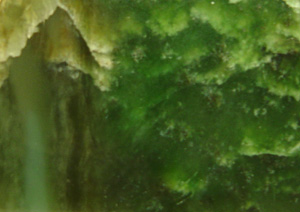Bowenite: Difference between revisions
no .. mere can be bigger (ref. http://www.shopenzed.com/full-size-maori-greenstone-pounamu-mere-club-xidp122231.html) |
restore some words that got lost in recent edits |
||
| Line 1: | Line 1: | ||
[[Image:serpentine-bowenite.jpg|right|frame|Polished slab of bowenite serpentine, a variety of [[antigorite]].]] |
[[Image:serpentine-bowenite.jpg|right|frame|Polished slab of bowenite serpentine, a variety of [[antigorite]].]] |
||
'''Bowenite''' is a hard, compact variety of the [[serpentinite]] species [[antigorite]], (Mg<sub>3</sub>(OH)O<sub>4</sub>Si<sub>2</sub>O<sub>5</sub>)<ref>[http://www.crownminerals.govt.nz/cms/pdf-library/minerals/minerals-overview-pdfs-1/CO11916_7_Pounamu.pdf]</ref>. Classed as semi-precious gem stone<ref>[http://www.ri.gov/facts/factsfigures.php]</ref> it has been used for tools, weapons and jewellery by the [[Māori people|Māori]] in [[New Zealand]], and for jewellery by [[House of Fabergé|Fabergé]]<ref>[http://www.christies.com/LotFinder/lot_details.aspx?intObjectID=5307035]</ref>. Deposits are found in several places around the world including [[Afghanistan]], [[China]], [[New Zealand]], [[South Africa]] and the [[United States]]. It typically ranges in colour from |
'''Bowenite''' is a hard, compact variety of the [[serpentinite]] species [[antigorite]], (Mg<sub>3</sub>(OH)O<sub>4</sub>Si<sub>2</sub>O<sub>5</sub>)<ref>[http://www.crownminerals.govt.nz/cms/pdf-library/minerals/minerals-overview-pdfs-1/CO11916_7_Pounamu.pdf]</ref>. Classed as semi-precious gem stone<ref>[http://www.ri.gov/facts/factsfigures.php]</ref> it has been used for tools, weapons and jewellery by the [[Māori people|Māori]] in [[New Zealand]], and for jewellery by [[House of Fabergé|Fabergé]]<ref>[http://www.christies.com/LotFinder/lot_details.aspx?intObjectID=5307035]</ref>. Deposits are found in several places around the world including [[Afghanistan]], [[China]], [[New Zealand]], [[South Africa]] and the [[United States]]. It typically ranges in colour from dark green to light olive green, and in shades approaching yellow. Bowenite was named by [[James D. Dana]] in 1850 after George T. Bowen, who analyzed it in 1822. |
||
[[Image:Pounamu pendant.jpg|thumb|left|220px|Pounamu pendant.]] |
[[Image:Pounamu pendant.jpg|thumb|left|220px|Pounamu pendant.]] |
||
Revision as of 03:15, 11 March 2011

Bowenite is a hard, compact variety of the serpentinite species antigorite, (Mg3(OH)O4Si2O5)[1]. Classed as semi-precious gem stone[2] it has been used for tools, weapons and jewellery by the Māori in New Zealand, and for jewellery by Fabergé[3]. Deposits are found in several places around the world including Afghanistan, China, New Zealand, South Africa and the United States. It typically ranges in colour from dark green to light olive green, and in shades approaching yellow. Bowenite was named by James D. Dana in 1850 after George T. Bowen, who analyzed it in 1822.

Together with nephrite jade the Māori class bowenite as pounamu, which is also known as greenstone, and is of particular significance to the Ngai Tahu iwi on whose traditional lands on the South Island of New Zealand most deposits are found[4]. Historically it was used tools, weapons and ornaments, although modern use is limited to jewellery, such as Tiki[5][6][7]. The South Island deposits are legally protected, and taking material without Ngai Tahu permission has led to prosecutions[8]. In 1992 Ngai Tahu approved the 'Pounamu Resource Management Plan' to manage deposits of this commercially valuable resource[9].
Bowenite is the the state mineral of the US state of Rhode Island[10].
Most deposits of bowenite are small, although a large deposit was discovered in South Africa in 1989. Deposits in China are in the Soochow region, which accounts for its also being known as Soochow jade. [citation needed]
